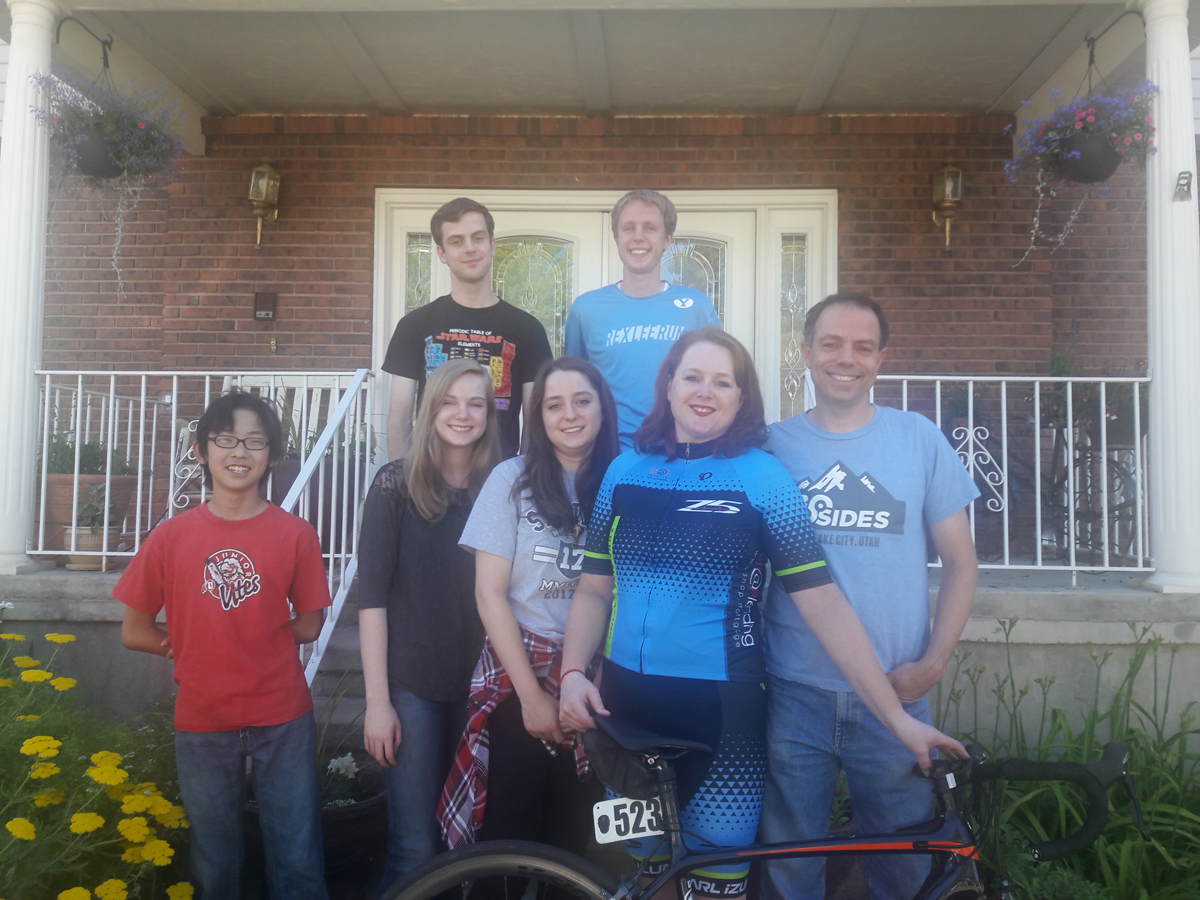By Kelly McPherson — First and foremost, I am a mom and a wife with all of the responsibilities, joys and struggles those titles encompass. I have five kids with ages ranging from 12 to 24, three cats, a dog, a lizard and 3 fish. My husband and I are currently rehabilitating a large and very distressed home. I am also working full-time with a 45 minute commute each way. On top of all of that, I have decided that this year is the year that I will complete 3 of my bucket list events, Crusher in the Tushar, Seattle to Portland and Lotoja. Those who are familiar with these events will know that my training load is currently between 10-15 hours per week.

I may be insane! True! Still, below are some of the things I have learned that might help those of us trying to keep sanity around this crazy sport.
-
- Identify the why. This may seem obvious, but if you don’t know why you are training then you aren’t very likely to make and stick with a plan to complete it. Training is hard! For me, the why is to keep Type II diabetes under control and to model healthy behaviors for my children so they will not be as likely to battle the obesity related problems that I have had.
- Develop your support crew. Enlist the help of those around you. This could be in the form of a husband, BFF, neighbor, extended family member or, in my case, a crew of kids and a husband who are taking on more responsibilities around the house so that I have more time to make training a priority. Make sure to ask them for what you need and express gratitude when they give it to you. Make sure to communicate with them what your plans are and when those plans change. Make sure to return the favor occasionally by sacrificing training time to help them reach a goal of their own. Your support crew is your single most valuable asset. Make sure that they know it and can truly feel your appreciation. Get completely off your bike physically and emotionally, and be totally present with them when you are not training.
- Have a plan. If you don’t have a written plan, you will spend too much valuable time trying to decide what to do and then second-guessing yourself as to whether or not you are doing the right kind of work to reach your goal. This can be a plan you write yourself, have a coach help you with or something you find pre-canned on the internet. Do what is best for you. The point here is that you don’t have time to be messing around with workouts that are not in line with your goals. Get a good plan together and then stick with it.
- Time your training. This will take a little experimentation to get right and even then, you will sometimes need to be flexible and have a plan B or C. For me, I am really blessed to work for an employer who lets me train at lunchtime. If I need a little longer session than what would fit in my lunch hour, I just stay a little later to make up the time. This is my favorite time to train. I eat at my desk when I get back and then, when I get home, I don’t need to leave my family again. Plan B, for me, is the evening, after work sessions, but I try to avoid them as much as I can so I can be there for my family to make dinner, help with homework, etc. My plan C is the early morning session on my trainer. This is just a personal preference, but I am just as likely to lie on the floor next to my trainer and sleep as I am to actually get onto it. I usually try to get my Saturday workouts in early in the morning as I have teenagers and some of them don’t get up before noon anyway. If I had little ones who went to bed early, I might try training in the evenings so they would be asleep for part of the time. The bottom line is to try to get your training completed when it has the least amount of impact on those around you. Help those you love understand the priority you need to place on training, but be flexible enough to get it done, when possible, at times when they aren’t needing you as much.
- Be prepared for anything. Sometimes the opportunity to train comes at unexpected times. Be sure you are ready to take advantage of those moments. For me, this means that the trunk of my car is where I store a large portion of my bike gear, including my bike. That way if we get unexpectedly good weather, I can ride.
- Find the shortcuts. There are lots of these, but here are a few to get your creative juices flowing.
- Make a menu and post it, with the recipes, somewhere everyone in the household can see it so that dinner can be made even when you aren’t home.
- Order your groceries online and then just pick them up, or better yet, have a member of your support crew do it for you. I love coming home from work to find that my kids went and picked up the groceries I had ordered and have put them away. Nice!
- Set up automatic watering of your flowerpots and garden boxes. I realize that not everyone loves to grow things, but I do and it takes me more than an hour each day to water everything so that I don’t have to buy zucchini at the grocery store in August. I do not have that hour each day.
- Hire out what you need to. Is mowing the lawn something you really have time to do? Or can you pay your son or the neighbor kid to do it for you?
- Change your perspective. Many people, especially women, feel guilty training because it is taking time away from their families. This is hard. While I would never recommend abandoning your family excessively so that you can ride forever, I would suggest that you take a good look at how much your family does actually need you. Parenthood is an exercise in planned obsolescence. We want our kids to learn how to do things on their own and to be able to live without you. If you are never gone, that won’t happen. You do not need to do everything for them. Because of this perspective, my kids know how to cook, clean, do laundry, get themselves to their own lessons, medical appointments and to manage their own homework schedules. I will have three leaving home to go to college this fall and I am totally confident that they each will be completely capable of successfully managing their lives. I am highly involved in their lives in the important areas such as quality time spent together playing games, going on trips and chatting about anything and everything in lawn chairs on the deck. Why would I waste time doing for them the things that they need to learn to do for themselves?
Another perspective which I have found helpful is that I want to be an example of the kind of person that I want my kids to grow up to be and I want to teach them they need to work hard to get there. I have seen so many people put their lives on hold for their families. Their children never get to see them with the passion and drive that they had in their youth. They never get to see them have a goal or a dream, make a plan, have struggles, overcome adversity and work hard to reach their goal. They never get to see their parents fail, pick themselves up and try again. This is an extremely valuable process for kids to observe and strive to imitate. If I want my children to continue, through adulthood, to set goals and then work hard to achieve them, then that is what I need to show them.
Between work, family and community responsibilities, finding time to consistently train and to reach for goals that scare you is tough. Through attitude checks and careful planning, it can be done if you are fully committed to your goals. Plans are messy and constantly changing, but well worth it, in my opinion. Go for it! You got this!







